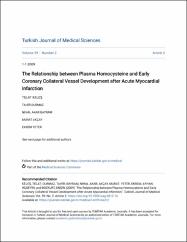The relationship between plasma homocysteine and early coronary collateral vessel development after acute myocardial infarction

View/
Access
info:eu-repo/semantics/openAccessDate
2009Author
Keleş, TelatDurmaz, Tahir
Bayram, Akar Nihal
Akçay, Murat
Yeter, Ekrem
Ayhan, Hüseyin
Bozkurt, Engin
Metadata
Show full item recordCitation
Keleş, T., Durmaz, T., Bayram, N.A., Akçay, m., Yeter, E., Ayhan, H. & Bozkurt, E. (2009). The relationship between plasma homocysteine and early coronary collateral vessel development after acute myocardial infarction. Turkish Journal of Medical Sciences, 39(2), 167-172.Abstract
Amaç: Homosisteinin endotelyal hücre proliferasyonunu inhibe ettiği bilinmektedir. Koroner kollateral dolaşımın gelişimini etkileyen faktörler iyi bilinmemektedir. Bu çalışmada plazma homosistein düzeylerinin akut miyokard infarktüsü sonrası anjiyografik olarak saptanabilen kollaterallerin gelişimi üzerine tekisi araştırılmıştır. Yöntem ve Gereç: Çalışmaya akut ST yükselmeli miyokard infarktüsü geçiren 60 hasta alınmıştır. Tüm hastalara hastaneye yatırıldıktan sonraki 1-4. günler arasında koroner anjiyografi yapılmıştır (ortalama 2,3 ± 1,2 gün). Kollateral damar gelişimi rentrop sınıflamasına göre derecelendirilmiş, 0 ve 1 kötü kollateral gelişimi, 2 ve 3 ise iyi kollateral gelişimi olarak gruplandırılmıştır. Bulgular: 35 hastada (% 58,3) kötü kollateral gelişimi saptanmıştır. Geri kalan 25 hastada ise (% 41,7) kollateral gelişimin iyi olduğu görülmüştür. Ortalama plasma homosistein konsantrasyonu kötü ve iyi kollateral grublarında sırasıyla 18,2 ± 8,6 ?mol/l ve 12,7 ± 2,4 ?mol/l bulunmuştur (P = 0,008). Rentrop sınıfı ile homosistein düzeyi arasında anlamlı negatif korelasyon olduğu görülmüştür (r = –0,391, P = 0,002). Yaş, cinsiyet, hipertansiyon, diyabet varlığı, sigara alışkanlığı, plazma lipid parametreleri ve homosistein konsantrasyonlarının kollateral gelişimi üzerine etkisine bakıldığında, kollateral gelişini etkileyen tek bağımsız değişkenin homosistein olduğu görülmüştür (OR: 0,71; % 95 güven aralığı 0,57-0,89, P = 0,003). Sonuç: Bu çalışma ile plazma homosistein konsantrasyonları ile akut miyokard infarktüsü sonrası erken dönemdeki kollateral gelişimi arasındaki negatif ilişkinin varlığı ilk kez gösterilmiştir. Aim: Homocysteine is known to inhibit endothelial cell proliferation, which is a key event in angiogenesis. Factors responsible for the presence or absence of coronary collateral circulation are poorly understood. Therefore, in this study we investigated the effect of plasma homocysteine level on the early formation of angiographically visible collaterals after acute myocardial infarction. Materials and Methods: The study included 60 patients that had ST-segment elevation myocardial infarction (STEMI). All the patients underwent coronary angiography 1-4 days after admission (mean: 2.3 ± 1.2 days). Patients were graded according to Rentrop classification. Patients with grade 0 or 1 collateral vessels were classified as poor collaterals; patients with grade 2 or 3 collateral vessels were classified as good collaterals. Results: In all, 35 (58.3%) patients had poor collateral vessel filling and the remaining 25 (41.7%) patients had good collateral filling. Plasma homocysteine concentration in patients with poor and good collateral formation was 18.2 ± 8.6 µmol/l and 12.7 ± 2.4 µmol/l, respectively (P = 0.008). There was a negative linear correlation between Rentrop subclasses and plasma homocysteine concentration (r = –0.391, P = 0.002). We assessed the effect of demographic variables, such as age, gender, hypertension, diabetes mellitus, smoking, lipid parameters, and plasma homocysteine concentration, on the development of collaterals. The only independent variable that affected the development of collaterals was homocysteine level (OR: 0.71; 95% CI = 0.57-0.89, P = 0.003). Conclusions: This study demonstrates for the first time that there is an inverse relationship between the early development of collateral circulation after acute myocardial infarction and plasma homocysteine concentration.

















